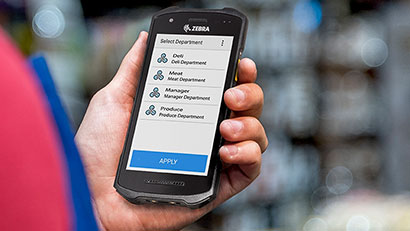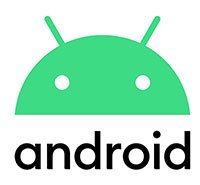|
Zebra TC21/TC26
Rugged, value-driven 5-inch Android 10-based mobile computer and data collection devices for retail, hospitality and enterprise customers
(by Conrad H. Blickenstorfer)
Share on:



On June 23, 2020, Zebra Technologies Corporation launched the Android-based TC21/TC26 as rugged, value-driven enterprise handheld touch computers for small and medium-sized businesses. What's thee difference between the two? The WiFi-only TC21 for workers inside the four walls and the TC26 with WiFi and cellular data for workers out in the field.

Overall, TC21/TC26 looks and feels much like a modern Android smartphone, and that was Zebra's idea behind it: provide a design and familiar user interface in a reasonably priced device that's geared towards the data collection and communication needs of retail, hospitality and enterprise customers.
Improvement of a platform
Note that the TC21/TC26 is an evolution of the existing TC20/TC25. Zebra introduced the original TC20 late 2017 around the same time as Microsoft called it quits on Windows 10 Mobile, meaning Zebra had bet on the right horse with its early emphasis on Android in the handheld space. The TC20 was available as touch-only or with a hardware keyboard. The touch-only TC25 was introduced early 2018 as a better-sealed mobile broadband equipped version.
The new TC21/TC26 is touch-only and no longer offers a keypad formfactor option. Also, both versions are now equally well-sealed, so the only difference between the two is cellular data for use in the field.
 There are, however, very noticeable advances in the TC21/TC26 compared to the original TC20/TC25. The operating system jumped from Android 7 to the much more competent Android 10 (Zebra says it's the first device in its class to offer Android 10), and it promises support for future Android generations. That's great news as in the past Android devices were often stuck with a certain version. There are, however, very noticeable advances in the TC21/TC26 compared to the original TC20/TC25. The operating system jumped from Android 7 to the much more competent Android 10 (Zebra says it's the first device in its class to offer Android 10), and it promises support for future Android generations. That's great news as in the past Android devices were often stuck with a certain version.
The new Snapdragon 660-powered TC21/TC26 should also be significantly quicker (we estimate about 60% faster overall) than its SD430-based predecessor. The octa-core SD660 has pretty much become the workhorse for ruggedized handhelds and tablets, so this was a good choice.
And while early versions of Android did not meet enterprise security standards and requirements, Android security has been ramped up in leaps and bounds.
In addition to what's baked into Android 10 in terms of security, Zebra offers LifeGuard for Android that adds years of OS security support via periodic security updates and legacy OS security support to match the enterprise hardware lifecycle.
And with Zebra being one of the earliest adopters of Android for enterprise solutions, the company has compiled significant experience and makes that available in its "Mobility DNA," an integrated and ever-growing suite of business, management, productivity and development tools. There are so many extensions available by now that customers can decide which features to activate and configure via Zebra's Enterprise Mobility Management tool kit.
What does the TC21/TC26 offer?
With the new TC21/TC26, Zebra provides a timely update to its versatile, sensible, durable handheld for use around the workplace. It still looks, feels and handles like a modern smartphone and almost anyone will instantly be familiar with it, but the smallish old 4.3-inch screen of the TC20/TC25 has been replaced by a larger 5-inch screen that's sharper to boot (294 vs 217 ppi).
The battery situation has been improved as well. Whereas the original TC20/TC25 had an internal, non-removable battery and the only way to keep going when the charge ran out was an optional snap-on "PowerPack," the new TC21/TC26 has a removable battery. The standard 3100mAH battery should last about 10 hours on a charge, and an optional 5,400mAH extended battery boosts to 14 hours. A much better solution.
Cameras have been improved as well. The rear camera is now at 13mp, up from 8mp in the older version. And a 5mp user-facing camera for video calls is also available.
Enterprise-grade scanning options
What sets professional and enterprise mobile computing devices apart from standard consumer smartphones is not only greater ruggedness and durability, but also the availability of industrial-grade scanning. TC21/TC26 users can either opt for the Zebra SE4100 (light to moderate scan requirements) or the Zebra SE4710 (high performance) scan engines. For TC21/TC26 customers, what it boils down to is whether they'll use their handheld for just occasional scanning or frequent scanning. A snap-on trigger handle and wearable arm mount are optionally available, as are various charge and communications cradles (see all accessories).
Connectivity galore
On the connectivity and communications side, there's dual-band 802.11 a/b/g/n/ac/d/h/i/r/k WiFi, Bluetooth 5.0 BLE, and, for the TC26, mobile broadband using a Nano SIM (or, optionally, an eSIM). There is a speaker, of course, and dual microphones for maximum voice clarity on PTT Pro or PTT Express Push-To-Talk calls. With the press of a button, users can reach a specific contact, a specific group of contacts, or everyone in the group. The TC21/TC26 supports USB OTG host and client via a USB Type-C port. Positioning is via A-GPS that supports GPS, Glonass, BeiDou, and Galileo.
Tough and rugged as can be
Although built to handle plenty of abuse, at just over 8 ounces the TC21/TC26 is no heavier than your average consumer phone in a case. Its footprint is roughly that of an iPhone 11 Pro Max, but with its extra protection the TC21/TC26, of course, is thicker (14 vs 8mm). In return for the thickness and weight users not only get an integrated industrial-grade scanner, but also remarkable ruggedness.
There's now IP67 sealing for both versions (vs IP54 and IP65 for the old TC20 and TC25), which means the new models are fully protected against dust and can also handle full immersion. The devices can also handle 4-foot drops to concrete, 300 tumbles from a height of half a meter, all sorts of vibration, thermal shock, humidity, etc. The operating temperature range is 14 to 122 degrees Fahrenheit, good enough for use in virtually any business. And the screen is protected by Corning Gorilla Glass.
A great addition to the Zebra TC lineup
What Zebra has done with the new TC21/TC26 is smartly upgrade and update the low-end offering in its TC Series line of touch computers. With their bigger screens, the new models are a bit larger and heavier than their predecessors, but the same happened in smartphones and everyone got used to that. The replaceable battery, larger screen, and increased performance add to their appeal.
The Zebra TC21/TC26 is now technologically up-to-date, both on the hardware and on the software side, it's tough enough for enterprise use, it's light and handy enough to go anywhere, but with a screen large enough to get the job done. -- C. H. Blickenstorfer, June 2020
|



